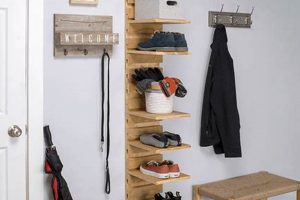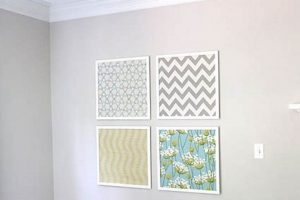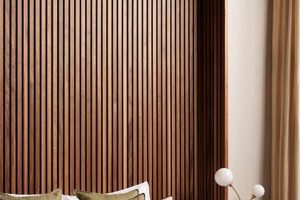The practice involves the self-directed installation of decorative molding or edging to interior vertical surfaces. This activity encompasses a range of materials, including wood, MDF, and PVC, cut and affixed to a desired area. For example, an individual might choose to install baseboards along the bottom of a room’s perimeter, adding visual interest and protecting the wall from scuffs.
This endeavor offers several advantages, from enhancing the aesthetic appeal of a space to increasing property value. Historically, ornamentation of this kind served a purely decorative function in affluent homes. Today, it allows homeowners to personalize their living environments and implement cost-effective upgrades. Furthermore, the skills acquired through completing such a project can lead to further home improvement capabilities.
Subsequent sections will delve into the necessary tools and materials, outline step-by-step installation procedures, and address common challenges encountered during the process. Safety precautions and creative design options will also be examined. This information will equip readers with the knowledge required to undertake the task successfully.
Essential Guidance for Decorative Wall Paneling Undertakings
The following guidelines are presented to optimize the outcome of self-directed decorative wall paneling installation. Adherence to these recommendations can minimize errors and improve the overall quality of the finished product.
Tip 1: Accurate Measurement is Paramount: Prior to material procurement, meticulously measure the intended surfaces. Precise measurements minimize material waste and ensure seamless alignment during installation.
Tip 2: Material Selection Should Reflect Environmental Conditions: Consider the humidity levels within the space. In moisture-prone areas, PVC or pre-primed materials resist warping and degradation more effectively than raw wood.
Tip 3: Proper Surface Preparation Yields Optimal Adhesion: Ensure the wall surface is clean, dry, and free from loose paint or debris. Priming enhances adhesion and creates a uniform surface for applying adhesives or fasteners.
Tip 4: Mitering Techniques Require Precision: When joining trim pieces at corners, employ a high-quality miter saw and exercise caution to achieve accurate angles. Inaccurate miters compromise the visual appeal and structural integrity of the installation.
Tip 5: Fastener Selection Impacts Stability: Choose appropriate fasteners based on the wall material and the weight of the trim. Insufficient fastening leads to instability and potential detachment over time.
Tip 6: Utilize a Level and Laser for Alignment: Precise horizontal and vertical alignment is crucial. Employing a level and laser ensures consistent positioning, preventing unsightly deviations.
Tip 7: Fill Nail Holes and Caulk Seams for a Professional Finish: After installation, fill all nail holes with wood filler and caulk any gaps between the trim and the wall. This creates a seamless and polished appearance.
Diligent attention to measurement, material selection, surface preparation, mitering, fastening, alignment, and finishing work yields professional results and long-term satisfaction.
The subsequent section provides information about advanced techniques and stylistic considerations for enhancing the decorative impact of installed trim.
1. Precise Measurements
Accurate linear dimension assessment constitutes a foundational element within any decorative wall paneling undertaking. Incorrect measurements invariably lead to material wastage, disjointed seams, and an overall compromised aesthetic. The relationship is causal: imprecise measurements directly generate flawed outcomes. Consider the installation of chair railing; if room dimensions are inaccurately gauged, sections may be either too short, necessitating unsightly splices, or too long, resulting in unnecessary material removal and potential damage. The accuracy in dimension assessment is therefore not merely desirable but a practical necessity for a successful outcome.
The impact of precise measurements extends beyond mere aesthetics; it also influences the structural integrity of the installation. In situations where trim pieces are intended to provide support or conceal imperfections, inaccurate dimensions can undermine the intended function. For instance, baseboards installed with dimension errors may fail to effectively cover the junction between the wall and flooring, leaving an unsightly gap susceptible to moisture and debris accumulation. Furthermore, precise dimensioning is crucial when calculating the miter angles for corner joints. Deviations from the calculated angles directly translate to visible gaps and a lack of professional finish.
In conclusion, dimensional precision is inextricably linked to the success of any wall embellishment project. The absence of accurate assessment leads to increased material expenses, diminished aesthetic appeal, and potential structural issues. Overcoming the challenge of dimension errors necessitates the employment of reliable measuring tools, a methodical approach to data collection, and meticulous attention to detail throughout the planning and execution phases. The resulting installation exhibits improved quality, longevity, and aesthetic value, ultimately fulfilling the intended purpose of the decorative enhancement.
2. Material Selection
Within the scope of decorative wall paneling undertakings, material selection represents a pivotal decision-making juncture. The choice of material directly influences not only the aesthetic outcome but also the longevity, maintenance requirements, and overall cost-effectiveness of the installation. Informed selection requires a comprehensive understanding of available options and their respective properties.
- Wood (Solid or Engineered)
Solid wood offers a classic aesthetic and can be stained or painted to match existing decor. However, it is susceptible to moisture damage and expansion/contraction based on humidity levels. Engineered wood, such as MDF (Medium-Density Fiberboard), provides a more stable alternative, being less prone to warping. While MDF is cost-effective and easily workable, it is also sensitive to moisture and may require careful sealing in damp environments. Both options exemplify how material composition affects suitability.
- Polyvinyl Chloride (PVC)
PVC presents a durable and moisture-resistant option. It is particularly well-suited for areas with high humidity, such as bathrooms or kitchens, where wood-based materials may degrade over time. Furthermore, PVC trim is often pre-finished, reducing the need for painting or staining. The inherent properties of PVC render it a practical selection where environmental conditions pose a challenge to traditional materials.
- Polystyrene
Polystyrene trim offers a lightweight and cost-effective alternative to wood. It is often used for purely decorative applications where structural integrity is not a primary concern. While easy to cut and install, polystyrene is more susceptible to damage from impact than wood or PVC. Therefore, its application is generally confined to areas with minimal physical contact or wear.
- Composite Materials
Various composite materials, blending wood fibers with polymers, offer a balance of durability, moisture resistance, and workability. These materials often mimic the appearance of natural wood while mitigating some of its inherent drawbacks. The selection of a composite material can be a strategic compromise when seeking both aesthetic appeal and practical performance.
The implications of material selection resonate throughout the entire lifecycle of a trim installation. Cost, ease of installation, required maintenance, and long-term performance are all directly influenced by the initial material choice. Careful evaluation of these factors, informed by the specific environmental context and aesthetic objectives, is paramount to achieving a satisfactory and sustainable outcome.
3. Surface Preparation
Proper surface preparation is a non-negotiable prerequisite for successful decorative wall paneling installation. The adherence of trim pieces to the underlying wall surface is contingent upon a clean, stable, and properly prepared substrate. Inadequate preparation compromises adhesion, reduces lifespan, and diminishes the aesthetic quality of the finished product.
- Cleaning and Degreasing
The removal of dirt, dust, grease, and other contaminants is fundamental. These substances interfere with the bonding of adhesives and paints. For example, residue from cooking or cleaning products on kitchen walls must be eliminated prior to applying adhesive-backed trim. Failure to clean the surface can result in the trim peeling or detaching over time.
- Repairing Imperfections
Holes, cracks, and uneven surfaces must be addressed before installation. Patching compounds can be used to fill voids and create a smooth, uniform plane. Unevenness can lead to gaps between the trim and the wall, creating an unsightly appearance. Properly repaired surfaces provide a solid foundation for the trim and improve its overall stability.
- Sanding and Priming
Sanding removes loose paint and textures, creating a better surface for adhesion. Priming seals the surface, promotes uniform paint absorption, and enhances the bond between the wall and the trim. The absence of priming can lead to uneven paint coverage and premature peeling. Selecting an appropriate primer formulated for the trim material and wall type is crucial for long-term durability.
- Moisture Assessment and Mitigation
Elevated moisture levels can compromise the integrity of both the wall and the trim. Identifying and addressing sources of moisture, such as leaks or condensation, is essential. Installing trim on a damp surface can lead to warping, mold growth, and eventual failure of the installation. Addressing any sources of humidity prevents longer-term damage.
These surface preparation steps are not merely cosmetic; they are integral to ensuring the longevity, stability, and aesthetic appeal of any decorative wall paneling undertaking. Investing time and effort in thorough preparation translates to a more professional, durable, and visually pleasing result, safeguarding the investment in materials and labor.
4. Mitered Corners
Mitered corners are intrinsic to the successful execution of decorative wall paneling endeavors. Their purpose is to create seamless transitions at the intersections of trim pieces, typically at 90-degree angles, but also at other angles depending on the architectural design. In “wall trim diy,” the precision of these cuts directly influences the overall aesthetic quality. An accurately mitered corner creates a visually continuous line, lending a professional, finished appearance. Conversely, improperly mitered corners result in gaps, misalignments, and a compromised aesthetic, detracting from the intended visual impact. The relationship is causal: deficient mitering leads directly to substandard results in “wall trim diy” projects.
The practical significance of mastering mitered cuts extends beyond mere aesthetics. Well-executed corners contribute to the structural integrity of the installed trim. Gaps in the corners can allow moisture to penetrate, potentially leading to the deterioration of the trim and the underlying wall. In applications such as chair railing or crown molding, where trim pieces may provide a degree of support, poorly mitered corners can weaken the overall structure. The skill in creating accurate mitered joints improves the protective functioning of “wall trim diy”.
In summary, the proficiency in cutting mitered corners constitutes a critical component of any successful “wall trim diy” project. While the process presents challenges, including the need for precise measurements and specialized tools, the resulting improvement in aesthetic quality and structural integrity justifies the effort. Mastery of this skill enhances the overall value and durability of installed ornamentation.
5. Secure Fastening
Within the realm of self-directed decorative wall paneling installation, the element of secure fastening assumes paramount importance. It serves as the linchpin connecting the trim to the wall, ensuring its stability, longevity, and aesthetic integrity. Insufficient or inappropriate fastening methods invariably lead to compromised results, necessitating corrective measures and potentially diminishing the overall value of the project.
- Adhesive Selection and Application
The choice of adhesive must align with the materials involved and the environmental conditions of the space. For instance, construction adhesives designed for porous surfaces may prove inadequate for non-porous materials, resulting in a weak bond. Proper application involves even distribution, adequate coverage, and adherence to the manufacturer’s recommended curing times. Deviations from these guidelines can lead to premature detachment and instability.
- Mechanical Fasteners: Nails and Screws
The selection of appropriate nails or screws is crucial. Nail gauge and length should be sufficient to penetrate the trim and securely anchor it into the wall framing. For harder materials, pre-drilling pilot holes prevents splitting and facilitates easier insertion. Screws offer superior holding power compared to nails and are recommended for heavier trim pieces or areas subject to potential stress. The absence of adequate mechanical fastening invites instability and potential failure.
- Fastener Spacing and Placement
Consistent and appropriate fastener spacing is essential for distributing the load and preventing localized stress points. Overly wide spacing can lead to bowing or warping of the trim, while excessively close spacing can weaken the underlying material. Proper placement involves positioning fasteners strategically to maximize their holding power, such as near corners and along edges. Irregular fastener distribution compromises structural integrity and aesthetic alignment.
- Consideration of Wall Material
The composition of the wall (drywall, plaster, wood paneling, etc.) significantly influences the selection of fastening methods. Drywall requires specialized anchors to provide adequate holding power, while solid wood allows for direct fastening with nails or screws. Ignoring the wall material’s characteristics can result in ineffective fastening and potential damage to the wall itself. Utilizing correct anchors increases the efficacy of the installation.
These facets collectively underscore the critical role of secure fastening in successful “wall trim diy”. A holistic approach, encompassing appropriate adhesive selection, judicious use of mechanical fasteners, strategic spacing, and consideration of wall material, is indispensable for achieving a durable, visually appealing, and long-lasting trim installation. The efficacy of secure fastening directly correlates with the overall success of the project.
6. Finishing Touches
The efficacy of any decorative wall paneling installation is inextricably linked to the meticulous application of finishing touches. While precise measurements, appropriate material selection, and secure fastening establish a solid foundation, it is the final detailing that elevates the project from functional to aesthetically refined. These “finishing touches” encompass a range of procedures implemented to conceal imperfections, enhance visual harmony, and ensure the long-term integrity of the installation. Omission or inadequate execution of these procedures invariably diminishes the overall impact and perceived value of the endeavor.
Consider, for example, the task of filling nail holes and seams. Even when fasteners are skillfully applied, the resulting indentations detract from the smooth, continuous surface that is characteristic of professional wall paneling. The application of wood filler, carefully smoothed and sanded, eliminates these distractions, creating a seamless transition between the trim and the wall. Similarly, caulking applied along the edges of the trim conceals minor gaps, preventing the ingress of moisture and creating a clean, visually crisp border. This careful sealing is critical, particularly in moisture-prone environments such as bathrooms or kitchens, where water damage can rapidly compromise the installation’s integrity. The act of painting or staining also exemplifies a crucial “finishing touch”, allowing the homeowner to perfectly coordinate the trim with existing decor and to apply a protective layer that enhances durability and resistance to wear. The choice of finish and application method directly impacts the overall appearance and long-term performance of the wall trim.
In summary, “finishing touches” represent an indispensable component of any successful decorative wall paneling implementation. These procedures, encompassing the filling of imperfections, the application of protective sealants, and the meticulous choice of paint or stain, transcend mere cosmetic concerns. They directly contribute to the longevity, aesthetic appeal, and overall value of the installation. While demanding attention to detail and a degree of skill, the investment in these final steps yields a return that far surpasses the effort expended, ultimately transforming a functional modification into a refined and enduring addition to the interior environment.
Frequently Asked Questions About Wall Trim DIY
The following section addresses common inquiries regarding self-directed decorative wall paneling projects. These questions and answers aim to clarify procedures and mitigate potential challenges.
Question 1: What tools are absolutely essential for undertaking a trim installation?
A miter saw, level, measuring tape, nail gun or hammer, caulk gun, and safety glasses represent the core toolkit. Specific projects may necessitate additional tools, but these items are fundamental.
Question 2: What is the best method for cutting trim at an outside corner?
Employ a miter saw to cut each piece at a 45-degree angle, ensuring the cuts create a 90-degree corner when joined. Precise measurements are critical for proper alignment and a seamless appearance.
Question 3: How can gaps between the trim and wall be effectively concealed?
Caulking is the standard method for filling gaps. Apply a bead of paintable caulk along the seam and smooth it with a wet finger or a caulking tool for a clean finish.
Question 4: Is it necessary to prime trim before painting?
Priming is highly recommended. It seals the material, provides a uniform surface for paint adhesion, and improves the overall durability of the finish. Unprimed surfaces may absorb paint unevenly, leading to a less desirable result.
Question 5: What type of adhesive is most suitable for securing trim to drywall?
Construction adhesive specifically formulated for drywall is recommended. This type of adhesive offers a strong bond without damaging the drywall surface. Mechanical fasteners (nails) are often used in conjunction with adhesive for added security.
Question 6: How can one ensure consistent horizontal or vertical alignment of trim pieces?
A level and laser level are invaluable tools for maintaining consistent alignment. Regularly check the positioning of the trim as it is installed to prevent deviations and ensure a professional appearance. The use of a chalk line is also effective for creating straight lines.
Accurate execution and meticulous detailing are paramount for achieving professional outcomes. Adherence to basic principles improves the final installation.
The subsequent article will cover common errors and resolutions.
Wall Trim DIY
This exposition has explored the multi-faceted nature of “wall trim diy,” from foundational principles to nuanced finishing techniques. Precise measurement, judicious material selection, thorough surface preparation, accurate miter cuts, secure fastening methodologies, and detailed finishing processes have been delineated as critical determinants of success. The absence of due diligence in any of these areas invariably compromises the integrity and aesthetic value of the installation.
The attainment of proficiency in decorative wall paneling requires commitment to methodical execution and a scrupulous attention to detail. While challenges may arise, mastery of these skills confers both practical benefit and aesthetic enrichment, enhancing the value and appeal of interior spaces through self-directed craftsmanship. Further exploration of advanced techniques and design considerations may yield even more refined outcomes.


![Build a DIY Wheeled Patio Privacy Wall Screen [Easy!] The DIY Hub: Creative Crafts, Repairs & Life Hacks Build a DIY Wheeled Patio Privacy Wall Screen [Easy!] | The DIY Hub: Creative Crafts, Repairs & Life Hacks](https://craftingdiycenter.com/wp-content/uploads/2025/07/th-2201-300x200.jpg)




